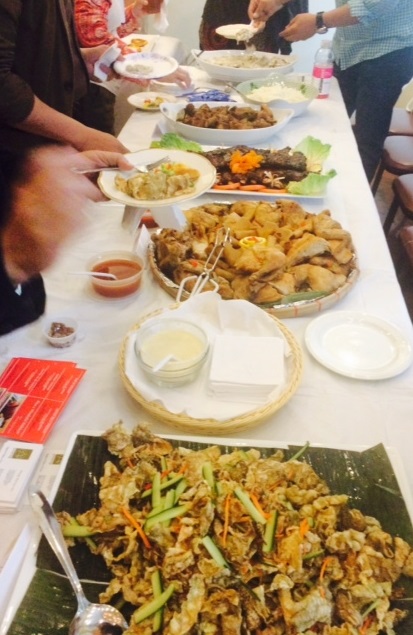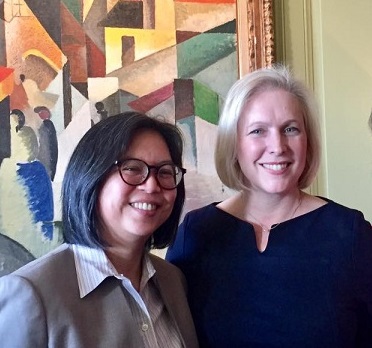Chefs rally behind Restaurant Week, but divided over ‘balut’ and notion of what makes Filipino food special

Top photo: Romy Dorotan of Purple Yam, Rose Teves of Grill 21, Yanina Erman of Jeepney-Maharlika, and Aris Tuazon of Ugly Kitchen.
Lower photo: Consul General Mario de Leon Jr., Rena Avendula of Payag, Neneth Albenio of Tito Rad’s, Manny Imperial of Phil-Am Kusina, and Maria Roldan of Max’s. The FilAm photos
Top chefs and restaurant owners gathered at the Philippine Center to support the launch of Filipino Restaurant Week (FRW) from May 11-23. While they all concede the event is sure to raise the profile of Philippine cuisine, they are divided on the issue of ‘balut’ being sold in restaurants.
“I love ‘balut,’ don’t get me wrong, but I will not sell it in my restaurant,” said Romy Dorotan, chef and owner of Purple Yam in Brooklyn. He said fertilized duck embryo – known as ‘balut’ to Filipinos — “trivializes” Filipino food. “We will always be known as the cuisine of the weird,” he said.
“I would like Filipino food to be known as healthy, delicious and has variety, but instead what to do we see in some restaurants? The ‘balut,’ the suckling pig,” Dorotan explained further to The FilAm.
The other restaurants that do not sell ‘balut’ are Max’s of Jersey City, Grill 21 in Gramercy, Payag Restaurant in Queens, Phil-Am Kusina in Staten Island, and Tito Rad’s Grill & Restaurant in Queens. Phil-Am and Payag said they are open to offering the ‘balut’ but supply and demand need to be met.

A spread of tasty specialties courtesy of the participating restaurants. Guests enjoyed the ‘beef lengua,’ ‘laing at bacalao,’ and the crisp fish skin chips. Photo by Vivian Talambiras Cruz
‘Balut’ is selling quite well in Maharlika and Jeepney owned and operated by Nicole Ponseca, and also in Ugly Kitchen co-owned by chef Aris Tuazon. Ponseca, who was absent at the press launch, has been known to popularize the ‘balut’ by offering it at her restaurants. She is on to her 3rd Annual Balut Eating Contest at the Hester Street Fair, an event that further mainstreams this duck egg slandered by some for its “disgusting look” and touted for its aphrodisiac quality.
“It has been my life’s mission and company goal to put Filipino food first,” she told NBC News in a September 2014 interview. Making the ‘balut’ acceptable to New Yorkers is up there in her list of gastronomic goals.
Ponseca is known to buck Filipino dining customs and to stay away from traditional ideas of what Filipino cuisine ought to be. She popularized ‘kamayan’ dining or eating with hands on banana leaves. Twice a week, Jeepney goes utensil-free for dinner. It is said to be a hit among diners, and reservations need to be booked months in advance.
“We started as a pop-up and blossomed into a restaurant,” said Jeepney-Maharlika publicist Yanina Erman, who represented Ponseca at the press launch. “We play around with different flavors, we are Michelin-rated, we’ve been featured in The New York Times and Washington Post. We are known to have started the Filipino food movement.”
Asked about their notion of what makes Filipino food special, Tito Rad’s Neneth Albenio was quick to reply, “My mother’s cooking!” She said her mother’s cooking is “authentic,” and that’s what Tito Rad’s has been serving up in its restaurant for more than eight years now.
“Home cooking” is what Payag proudly offers in its menu, said owner Rena Avendula. “Lasang Pinoy” is what their cooking aspires to be.
Maharlika offers a different route to the palate, by playing around with flavors and ingredients, according to Erman, to give traditional culinary favorites a fresh and flavorful taste.
“This is not like your mama’s cooking,” Maharlika declares on its website, noting how Filipino food has “remained in the shadows of our kitchen cupboards” and never crossed over to mainstream American diners.
Max’s Maria Roldan said “comfort food” best describes Filipino food. “It is a unique combination of Spanish, Chinese and other cultures,” she said.
Rose Teves of Grill 21 said Filipino food is truly a comfort food, known for being “tasteful and enjoyable to eat.”
Philippine dishes typically appeal to “meat lovers,” according to Aris Tuazon of Ugly Kitchen. In his restaurant, he said they can tweak the menu to make their servings healthier and acceptable even to vegetarians.
Consul General Mario de Leon Jr. welcomed the participation of the 13 restaurants to the first-ever restaurant week. He said the eateries will be offering a set menu for lunch for as little as $25 and $35 for dinner.
“It’s about time,” he said. “Filipino food has gained popularity in New York City and other metropolitan cities and called ‘the next big thing.’”
Just as important, he added, the FRW will showcase to New Yorkers the “authentic experience of Filipino food as an extension of our culture, identity and history.”
The 13 participating restaurants are: Maharlika, Jeepney, Ugly Kitchen, Grill 21, Kuma Inn, Payag Restaurant, Tito Rad’s Grill & Restaurant, House of Inasal, Purple Yam, Umi Nom, Max’s Restaurant, Talde, and Phil-Am Kusina. All of them represent the four boroughs of New York City, except the Bronx. Two are from Jersey City.














